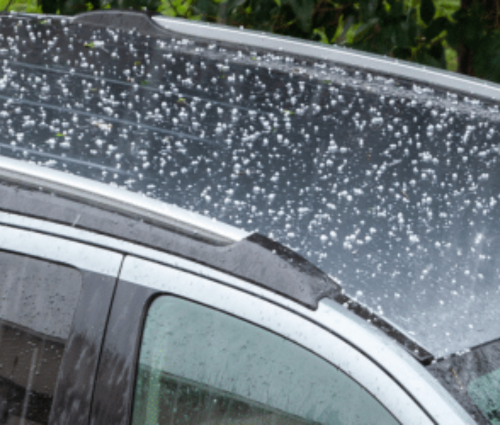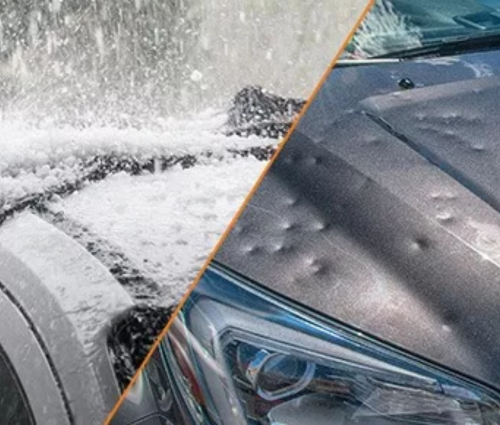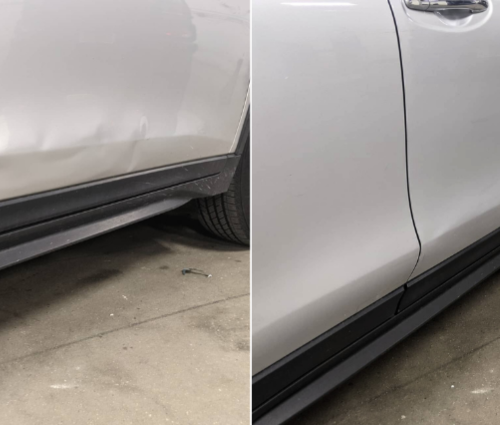The Hidden Costs of Ignoring Hail Damage
Hail Damage Risks
What Happens When Hail Damage Is Ignored

Leaving hail damage unaddressed might save time initially, but it often leads to more severe problems. Small dents and cracks in the vehicle’s paint expose the metal underneath to moisture. Over time, this exposure can result in rust that spreads, causing significant structural damage.
The longer the damage remains untreated, the more likely it is to worsen. Minor dents may grow into larger, more costly issues that require extensive repairs. Addressing hail damage promptly helps avoid these long-term complications and confirms the vehicle remains in optimal condition.

Different Impact of Delayed Repairs
Untreated dents and rust often worsen, turning what could have been a minor repair into a costly undertaking. As rust spreads, it weakens the vehicle’s panels, sometimes requiring panel replacements or more invasive repairs. The longer the damage is ignored, the more expensive and complex the repair process becomes.
Hail damage also directly impacts the vehicle’s resale value. Visible dents and signs of rust make a car less appealing to potential buyers. Vehicles with unresolved damage are often viewed as poorly maintained, leading to reduced offers or a longer time on the market. Buyers prioritize cars in excellent condition, so even minor hail damage can significantly lower resale value.
Delaying hail damage repairs can also affect insurance premiums and claims. Insurers may consider untreated damage a sign of neglect, which could lead to higher premiums or denied claims. If the damage worsens, insurance may only cover the initial repair costs, leaving the owner to pay the difference. Timely repairs using Paintless Dent Repair (PDR) prevent these issues.
Hail Damage and Vehicle Longevity Risks

Neglecting hail damage can significantly shorten a vehicle’s lifespan, creating issues that affect both its appearance and functionality. Small dents, especially those that break the paint layer, expose the metal underneath to moisture. Over time, this moisture leads to the development of rust. Rust begins as a minor blemish but can quickly spread across panels, eating away at the metal. If left untreated, rust compromises the structural integrity of the vehicle, weakening its body and making it more susceptible to further damage.
The structural impact of rust goes beyond aesthetics. As rust progresses, it can affect difficult areas of the car, such as support beams or seams. This deterioration reduces the vehicle’s durability and safety, potentially making it less capable of withstanding impacts or harsh conditions.

What begins as a minor issue can evolve into significant structural concerns that impact the car’s overall reliability. Ignoring hail damage also increases the complexity of future repairs. As damage worsens, simple fixes like Paintless Dent Repair (PDR) may no longer be viable. Advanced rust or structural issues often require invasive repair methods, such as panel replacements or extensive bodywork. These repairs are not only more labor-intensive but also significantly more expensive than addressing the problem early.
Taking action promptly with PDR can prevent these risks. PDR addresses dents before they escalate, preserving the factory paint and preventing rust from forming. By opting for timely repairs, vehicle owners confirm their car’s longevity, maintain its safety, and avoid costly and complex future repairs. Addressing hail damage early safeguards the vehicle’s value, functionality, and durability for years to come.
How Ignoring Hail Damage Affects Insurance
Delaying hail damage repairs can lead to serious insurance-related challenges that affect both claims and premiums. Insurance providers typically expect vehicle owners to address damage promptly. When hail damage is left unresolved for an extended period, insurers may view it as neglect and deny claims outright. This can leave owners responsible for covering the full cost of repairs.
Another consequence of delays is reduced payouts. If untreated damage worsens over time, insurers may only agree to cover the original repair estimate, based on the condition of the vehicle immediately after the hailstorm. The additional costs caused by prolonged exposure, such as rust or structural damage, are often excluded, leaving the owner to shoulder the extra expenses.
Ignoring hail damage can also impact future insurance premiums. When providers see a pattern of neglected maintenance or delayed repairs, they may classify the vehicle as a higher risk. This increased risk assessment often results in elevated premiums, costing vehicle owners more in the long run. Acting quickly to repair hail damage is the best way to avoid these complications.
Why Timely Repairs Are Cost-Effective
Addressing hail damage promptly is a smart decision that saves money and prevents more significant problems down the road. When repairs are handled early, they tend to be simpler and more affordable.
Techniques like Paintless Dent Repair (PDR) can efficiently remove dents without the need for invasive procedures, such as sanding or panel replacements. If hail damage is left unattended, however, minor dents can worsen, leading to more complex and costly fixes that could have been avoided.
One of the biggest risks of delaying repairs is the potential for rust and structural damage. When dents compromise the paint layer, they expose the underlying metal to moisture. This can result in rust formation, which spreads and weakens the vehicle’s body panels.

Once rust sets in, repairs often involve extensive bodywork and part replacements, drastically increasing costs and repair times. Preventing rust through timely repairs not only saves money but also protects the car’s structural integrity and reliability. Cars with visible dents, rust, or signs of neglected maintenance are less appealing to buyers and typically sell for less. Timely repairs keep the car looking well-maintained, assuring it retains its market value and attracts higher offers during resale.
Why PDR is Ideal for Hail Damage Repair
Paintless Dent Repair (PDR) is a highly efficient and cost-effective solution for restoring vehicles affected by hail damage. Unlike traditional repair methods that involve sanding, filling, and repainting, PDR uses specialized tools to carefully massage dents from the inside out. This non-invasive technique restores the original shape of the vehicle’s panels without disturbing the factory paint. PDR maintains the car’s factory finish, which is important for preserving its appearance and market value.
One of the main advantages of PDR is its affordability. Traditional methods often require additional materials like fillers and paint, along with extended labor hours for sanding and refinishing. These processes increase both the cost and time required for repairs. PDR, on the other hand, eliminates these extra steps, making it a faster and more economical option. For vehicle owners looking to save on repair costs without compromising quality, PDR is an excellent choice.
A car with its factory paint intact is more appealing to potential buyers, as it signals that the vehicle has been well-maintained and free from invasive repairs. This is particularly important when considering resale, as vehicles with consistent finishes tend to fetch higher offers. For hail-damaged vehicles, PDR offers a reliable, efficient, and budget-friendly solution. It restores the car’s original condition while protecting its structural integrity and value, making it the preferred method for professional repairs.
Act Quickly to Minimize Hail Damage Expenses

Addressing hail damage immediately after it occurs is a practical and cost-effective way to prevent future expenses. Small dents and paint damage can escalate if left untreated, leading to rust, structural weakening, and more expensive repairs over time. Early action not only preserves the vehicle’s condition but also assures that minor issues do not evolve into complex problems requiring extensive bodywork.
Timely repairs are also beneficial for maintaining a car’s resale value. A vehicle that appears well-maintained and free of visible damage attracts higher offers from buyers. Neglecting hail damage, on the other hand, can significantly lower its market appeal. Providers may deny or reduce payouts if damage is left unresolved for too long. Opting for Paintless Dent Repair (PDR) offers an efficient, affordable solution to protect investment.

Maintain Your Vehicle’s Value with Repairs
Ignoring hail damage may seem harmless at first, but it can result in serious long-term issues. Small dents that expose the metal beneath the paint are particularly vulnerable to moisture, leading to rust. This rust can spread and compromise the structural integrity of the vehicle, making repairs far more expensive and complicated than addressing the initial damage. Delaying repairs can also significantly lower the car’s resale value. Vehicles with visible dents or signs of rust are less appealing to buyers, who may question the overall maintenance of the vehicle.
Timely Paintless Dent Repair (PDR) offers an efficient and cost-effective solution. By addressing dents early, PDR restores the car’s appearance without damaging the original paint, maintaining its value and protecting against future problems. Acting quickly confirms your vehicle remains in excellent condition for years to come.

VIP Hail Service | Plano, TX
Professional Hail Repair
Stay Up-to-date With Our Content
Subscribe to learn more about our mission!


